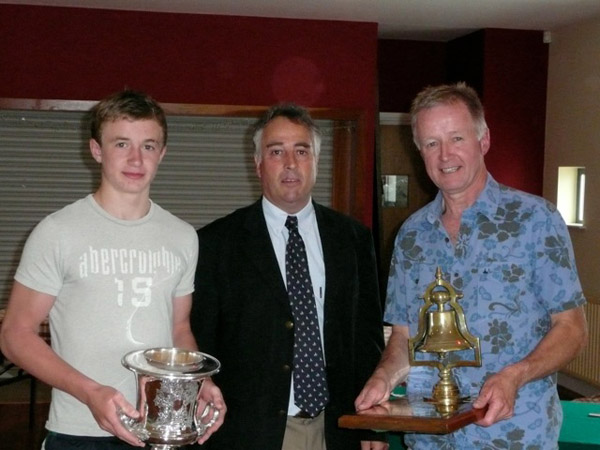Displaying items by tag: Hugh Gill
Sutton Dinghy Club's Andy Johnston is December's Sailor of the Month
#sailorofthemonth – Sutton Dinghy Club on the north shore of Dublin Bay has been a pace-setter in the revival of Irish dinghy racing and club activity generally during 2014. Commodore Andy Johnston led his members through an outstanding season in which they were once again making an impact at national and international level, while the club's training programme and sailing school under the direction of Hugh Gill was highly effective in bringing newcomers to the sport, and building up a strong esprit de corps among its dedicated team of young instructors. In addition to success in open dinghy events at all levels, SDC succeeded in regaining the historic Book Trophy for team racing from Royal Cork Yacht Club.
The trophy dates back to 1944, but for the past sixteen years the sailors of Crosshaven had kept it firmly in their grasp. 2014 also marked the 75th Anniversary of the foundation of the club at its homely base beside Sutton Creek, so the concluding highlight of the year was a 75th Anniversary Gala Dinner in mid-November in the club's home-from-home, the popular Marine Hotel at Sutton Cross. A remarkable total of 204 well-wishers and people who have distinguished sailing connections with Sutton DC from way back attended.
It was Ciara O'Tiarnaigh and her Organising Committee who looked after the nuts and bolts of this star-studded event, but throughout a long and very special season, it was Andy Johnston who led the way and held the ultimate responsibility. Nevertheless, in making him our Sailor of the Month for December 2014, we are saluting the spirit of Sutton Dinghy Club, and the resilience of all Irish dinghy sailing.
Dan Gill Becomes Youngest Ever GP Youth Champion
The GP14 Youth Championship 2010 was held at Sligo Yacht Club on Saturday 24th & 25th July in fresh Force 3 to 4 westerly winds with young sailors from six different clubs vying for honours. Senior sailors within the fleet loaned their boats to promising junior sailors from their home clubs in a bid to demonstrate the appeal of the class.
Don McCormack from Sligo Yacht Club led the fleet around the first weather mark followed closely by Cian Gallagher & Cathal Leigh Doyle also of Sligo Yacht Club in second and third respectively. With spinnakers flying in the strong breeze, the joy of sailing these boats on the reach quickly became apparent. However it was young Dan Gill from Sutton Dinghy Club who revelled in the conditions and quickly moved to the front of the fleet by the gybe mark. The race progressed and approaching the penultimate leeward mark it was Gill with a comfortable lead followed by McCormack and Leigh Doyle fighting it out for second place. Difficulties with the spinnaker in McCormack's boat ensured that Leigh Doyle had an easy second followed home in 3rd place by Conor Byrne & Pamela Lee of Royal St George Yacht Club.
Race 2 saw determined sailors Adam Scott and Eamonn Bourke of Skerries Sailing Club & Sutton Dinghy Club stake their claim on proceedings by sailing a great first beat to arrive at the windward mark in first place. Dave Reddy from Royal St George YC and crewed by stalwart of the class in Ireland Norman Lee arrived next followed closely by Dan Gill with his dad Hugh in the unfamiliar position of pulling the strings in the front for a change. Gill again showed his downwind prowess by moving into second but there was to be no getting past Scott & Bourke who went on to take the gun with the Gills holding onto second and Reddy & Lee taking third.
Race 3 on Sunday again saw the juniors having to hike hard to sail flat with Race Officer Gus Henry changing to a windward leeward course to give some variety. Racing was very close with the fleet bunched at the weather mark. But with a bow in front it was Byrne & Lee around first, then Reddy & Lee followed by the pack. The downwind leg presented lots of options and many were taken. Rounding onto the windward leg it was Byrne, then Reddy and again, young 14 year old Dan Gill not letting go, coming round in third. A tough windward battle ensued with Dan Gill showing perseverance and determination by rounding in first followed by Reddy and then Byrne. Gill led the fleet home with Reddy in second and getting more comfortable with the conditions were Eoin Duggan & Brendan Brogan of Sligo Yacht Club who sailed into third. This result saw Dan Gill become the youngest ever winner of the GP14 Youth Championship of Ireland with a race to spare.

Dan and Hugh Gill, Sutton Dinghy Club with the winning trophies. Photo: Donal McGuinness
Race 4 was again very keen with the fleet tightly bunched all the way round. Duggan & Brogan, getting better all the time, bagged a win followed by Reddy & Lee showing good consistency by again taking second with Cathal Leigh Doyle & James Conlon getting back into the frame with a third. All racers finished within twenty seconds showing remarkable competitiveness.
Final Placings
1. Dan & Hugh Gill, Sutton Dinghy Club
2. Dave Reddy & Norman Lee, Royal St George YC/ Greystones S
3. Eoin Duggan & Brendan Brogan, Sligo Yacht Club






























































